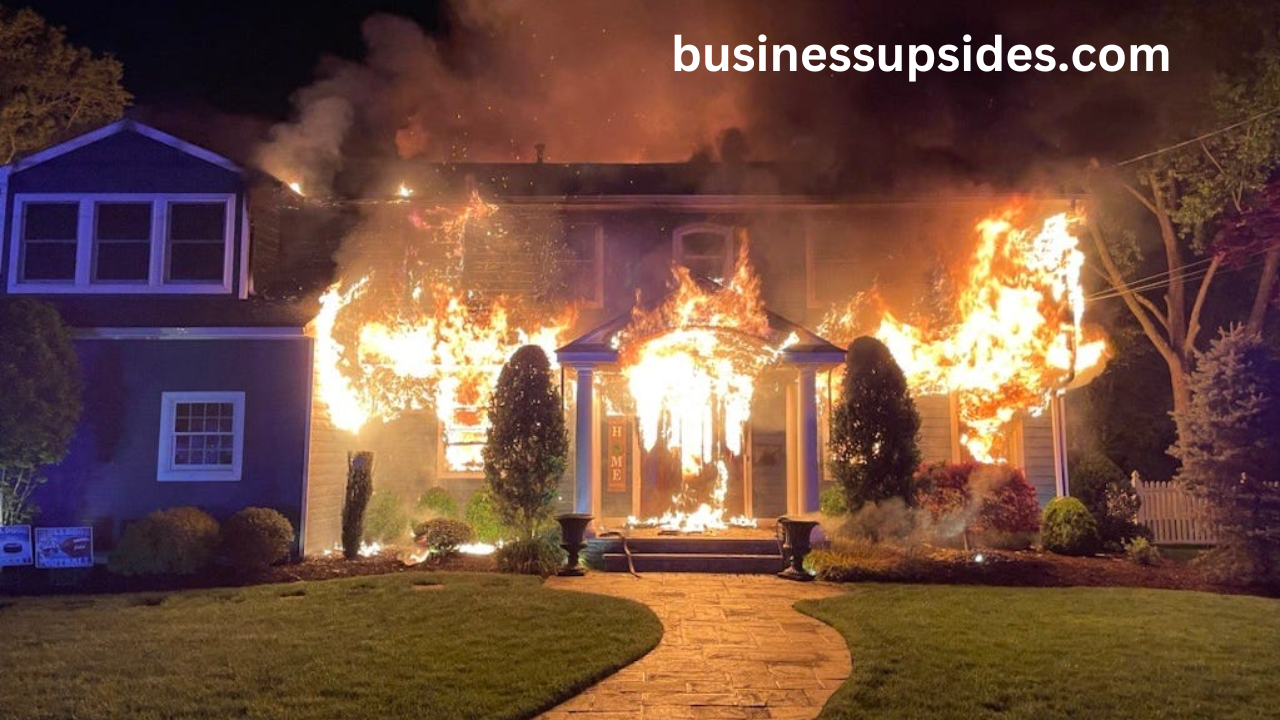House Fire Prevention, Impact, and Recovery
A house fire is one of the most devastating and dangerous events that can occur to a family, leaving not only physical damage but emotional and psychological scars as well. The dangers of house are real, and understanding how to prevent them, how to respond in the event of a fire, and how to recover afterward is vital for protecting both lives and property. In this article, we will explore the various aspects of house , including their causes, prevention tips, safety practices, and the recovery process.
Understanding House Fires
A house fire can be defined as an uncontrolled fire that begins in a home, typically igniting due to various causes such as cooking accidents, electrical malfunctions, or even arson. The fire can spread quickly through a building, fueled by combustible materials and aggravated by factors such as poor ventilation and delayed response times.
The Speed and Danger of Fires
House can escalate quickly. According to the National Fire Protection Association (NFPA), a fire can double in size every minute. Modern homes, with their open-plan designs and the prevalence of synthetic materials in furniture and building structures, burn faster than older homes. What may seem like a manageable fire can soon become a deadly inferno, overwhelming occupants and firefighters alike.
Common Causes of House Fires
While fires can start in various ways, some causes are more common than others. It’s important to be aware of these to reduce the risks of a fire starting in the first place.
1. Cooking Fires
Cooking-related incidents are one of the most common causes of fires. Leaving food unattended on a stove or in an oven is a frequent cause of these fires. Grease fires, in particular, can be especially dangerous because they spread rapidly and can be difficult to control without the right equipment.
Prevention:
- Always stay in the kitchen while cooking.
- If a grease fire occurs, cover it with a metal lid or use a fire extinguisher designed for grease fires.
- Keep flammable materials such as dish towels or oven mitts away from heat sources.
2. Electrical Fires
Faulty wiring, outdated electrical systems, and overloading outlets can lead to electrical fires. Appliances that are improperly maintained or used beyond their rated capacity can also spark fires. In some cases, electrical fires are not immediately apparent and may smolder before bursting into flames.
Prevention:
- Regularly inspect wiring and electrical appliances for wear and tear.
- Avoid overloading power strips or outlets.
- Hire a licensed electrician to repair or upgrade old wiring systems.
3. Heating Equipment House Fire
Space heaters, fireplaces, and other heating devices are another significant fire risk in homes, especially during colder months. If not properly maintained or used incorrectly, these heating devices can ignite nearby combustible materials such as furniture, clothing, or curtains.
Previous article; Dart on Board The Game, Its Evolution, and Growing Popularity
Prevention:
- Keep flammable materials at least three feet away from heating devices.
- Ensure regular maintenance for heating systems, including chimneys and vents.
- Turn off portable heaters when leaving the room or going to bed.
4. Smoking
Smoking materials, including cigarettes, cigars, and matches, are a leading cause of fires in homes. Discarding burning cigarette butts improperly, such as in trash cans or on balconies, can easily start a fire.
Prevention:
- Never smoke indoors, especially in bedrooms or near flammable objects.
- Always extinguish cigarettes completely before disposal.
- Use proper ashtrays designed to contain embers.
5. Arson
In some cases, house fires are intentionally set, either by an individual targeting a particular property or out of malicious intent. Arson can be challenging to detect immediately and can cause widespread damage.
Prevention:
- Install security systems, including surveillance cameras and motion detectors.
- Educate communities about the signs of suspicious behavior.
- Report any concerns of arson or unusual activity to authorities.
The Importance of Fire Safety
In the face of these potential causes of fires, it is crucial to implement fire safety measures. Being proactive can significantly reduce the risk of a fire breaking out. Here are some of the most effective fire safety practices:
1. Install Smoke Alarms and Carbon Monoxide Detectors
Having functional smoke alarms is one of the most important steps you can take to protect yourself and your family. Smoke detectors are designed to alert you in the event of a fire, giving you valuable time to evacuate the house. Likewise, carbon monoxide detectors can alert you to dangerous levels of carbon monoxide, which can result from faulty heating equipment or a fire.
Key Tips:
- Install smoke alarms on every level of your home and inside every sleeping area.
- Test smoke alarms monthly and replace the batteries at least once a year.
- Install carbon monoxide detectors in key areas near bedrooms and heating systems.
2. Develop a Fire Escape Plan
An escape plan is critical in case of a house fire. Each member of the household should know how to get out of the house quickly and safely. This includes identifying exit routes and designated meeting points.
Key Tips:
- Plan multiple escape routes from each room.
- Practice fire drills with all family members.
- Ensure that windows, doors, and exits are accessible and easy to open.
3. Keep Fire Extinguishers on Hand
Fire extinguishers can be lifesaving tools in the event of a small fire. Knowing how to use them effectively is crucial. Place fire extinguishers in key areas such as the kitchen, garage, and near any potential fire hazards.
Key Tips:
- Learn how to use a fire extinguisher using the PASS method: Pull the pin, Aim the nozzle, Squeeze the handle, and Sweep the nozzle.
- Maintain fire extinguishers by checking the pressure gauge and ensuring they are easily accessible.
- Keep extinguishers away from potential sources of fire, where they could become inaccessible.
4. Practice Safe Cooking Habits
As cooking fires are one of the leading causes of home fires, practicing safe cooking habits can make a big difference. Never leave cooking food unattended, and ensure the stove, oven, and any heating elements are turned off when not in use.
Key Tips:
- Keep the stovetop clean and free of grease buildup.
- Keep pot handles turned inward to prevent accidental knocks.
- Always use a timer when cooking and check on your food regularly.
Responding to a House Fire
In the event of a fire, staying calm and focused is key to survival.
- Alert Everyone: Sound the smoke alarm and shout to alert everyone in the house. Make sure all family members know to evacuate immediately.
- Evacuate Quickly: Use your pre-planned escape routes to leave the house. Avoid using elevators in high-rise buildings, as they can become traps in the event of a fire.
- Stay Low: If there is smoke in the air, stay close to the floor where the air is clearer.
- Close Doors Behind You: Closing doors behind you as you exit helps to slow the spread of fire and smoke.
- Call Emergency Services: Once safely outside, call the fire department or emergency services to report the fire.
If Trapped:
- If you are trapped in a room, stay near a window and signal for help. Cover your mouth and nose with a cloth to reduce inhalation of smoke.
- If you cannot exit the house safely, move to the safest room and call 911 to inform them of your location.
After the Fire: Recovery and Next Steps
The aftermath of a house fire can be emotionally and physically overwhelming. It’s important to understand the process of recovery and the steps needed to rebuild.
1. Ensure Your Safety
Once the fire has been extinguished, ensure the structure is safe to re-enter. Always wait for the fire department’s clearance before going back inside.
2. Document the Damage
Take photographs of the damage for insurance purposes. This documentation will help with the claims process and ensure you receive appropriate compensation.
3. Contact Your Insurance Provider
Notify your insurance company as soon as possible to begin the claims process. Your insurance policy may cover the costs of repairs, temporary housing, and even personal property loss.
4. Seek Emotional Support
House fires can take a heavy emotional toll on individuals and families. Seek professional counseling or support groups to help cope with trauma and loss.
5. Begin the Rebuilding Process
Once you’ve ensured your safety and completed the necessary paperwork, you can start the process of rebuilding your home. Work with trusted contractors and professionals to repair or reconstruct your home.
Conclusion
House fires are unpredictable, dangerous, and devastating events that can happen to anyone. Prevention, awareness, and safety measures are essential to reducing the risks associated with fires. By understanding the common causes, adopting fire safety practices, and knowing how to respond in the event of a fire, you can protect yourself and your family. Additionally, the recovery process is crucial, and with the right support, rebuilding after a fire is possible. Stay safe, stay prepared, and remember that your life and the safety of your loved ones are always the top priority.










Post Comment